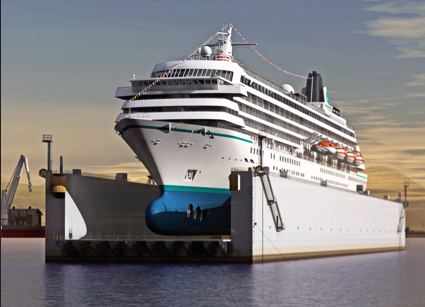The following is the text of a news release from Vigor Industrial:
(PORTLAND, Ore.) (Aug. 21) — The country’s largest floating dry dock, the Vigorous, is headed for Portland this weekend. The dry dock, a piece of equipment used to lift vessels as large as cruise ships out of the water, is scheduled to arrive at the mouth of the Columbia on Sunday. It will make its way up to Vigor Industrial’s Portland shipyard on the Willamette River by Sunday evening or Monday morning, depending on weather and river traffic.
Fully assembled, the dry dock will be 960 feet long. However, it is currently in three parts, which are stacked aboard a 738-foot heavy lift ship for delivery. The delivery provides unique opportunities to see both the new dry dock and the specialized ship carrying it up river.
Vigor is investing more than $50 million to build and deliver the Vigorous. The dry dock will allow Vigor to service vessels such as cruise ships, tankers and cargo ships. It also will free the company to send another dry dock from Portland to Seattle, expanding capacity there.
Vigor CEO Frank Foti says the new dry dock will allow the company to better serve a range of customers with large vessels at a time when total large dry dock capacity on the West Coast has been shrinking. Two large vessels, Maritime Administration cargo ships, are already booked for repairs when the dry dock enters service in November.
“The Vigorous is a symbol of the resurgence of the maritime industry in Portland and the wider Pacific Northwest,” said Foti. “Back in 2000, the shipyard was struggling. Today, we’re growing across the region, and I’m proud and profoundly grateful that we’re in a place to make this kind of investment.”
The Vigorous is about the same size as the dry dock Foti sold in 2001 in order to repay millions of dollars that the company owed lenders. The sale of the shipyard’s largest asset led some to speculate it was the end of shipbuilding in Portland. However, since then the company has grown from the single shipyard to nine locations from Portland to Seward, Alaska. The work force in Portland shipyard has expanded from fewer than 80 workers in the late 1990s to more than 600 today. Vigor’s overall work force now includes more than 2,000 people.
”The dry dock is attracting new business and new jobs to the region,” said Foti. “Without the Vigorous, these large ship repair projects and the family-wage shipyard jobs they create would just go somewhere else.”
Skilled shipyard workers can earn between $40,000 to $80,000 per year, and more with overtime, Foti said. On average, servicing the Algol and Capella cargo ships will create about 130 jobs each while those projects are underway at Vigor.
What is a floating dry dock?
A floating drydock is a U-shaped marine vessel used to repair and build ships. Operators let water into the dry dock through valves to submerge it, which allows other vessels to drive in and out of the dry dock. When the water is pumped out the dry dock rises, lifting docked vessels out of the water. This allows workers to service and repair parts of the vessel usually under the waterline.
Where is it coming from and how is it getting here?
The dry dock was constructed by Shanghai Zhenhua Heavy Industries in Jiangsu Province, China, and is being delivered to Portland aboard the Blue Marlin, a semi-submersible heavy lift ship owned by Dockwise Ltd. When the Blue Marlin arrives at the mouth of the Columbia, the ship will be guided over the Columbia River bar by the Columbia River Bar Pilots. Once past the bar, the ship will be transferred to the Columbia River Pilots for the trip up river to Portland.
Where can you see it?
There will be plenty of places to view the Vigorous and Blue Marlin as they make their way up river. For a map of some of the best spots to catch a glimpse from the shore, visit www.vigorindustrial.com/vigorous.
Boaters are advised to keep their distance to ensure safety. The Coast Guard, working with local law enforcement, will be patrolling the river to ensure the safety of all mariners during the transit of the Blue Marlin up the Columbia River. Boaters are responsible for helping maintain a clear shipping channel, including moving out of the way of commercial vessels transiting the river. The latest safety information about local navigation issues can be found here on the Coast Guard’s navigation center website. However, all boaters are encouraged to monitor marine VHF channel 16 for updates and changes.

